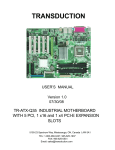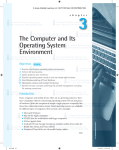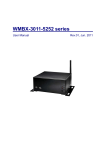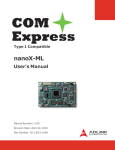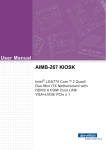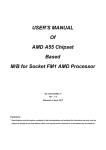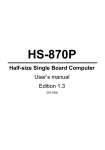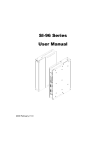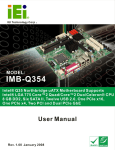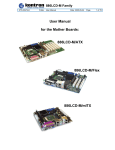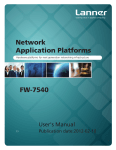Download ATX-E15
Transcript
ATX-E15 ATX Core2Quad Main Board User’s Manual Version 1.0 Copyright Notice This publication is protected by copyright and all rights are reserved. No part of it may be reproduced or transmitted by any means or in any form, without prior consent of the original manufacturer. The information in this document has been carefully checked and is believed to be accurate. However, the original manufacturer assumes no responsibility for any inaccuracies that may appear in this manual. In no event will the original manufacturer be liable for direct, indirect, special, exemplary, incidental, incidental or consequential damages resulting from any defect or omission in this manual, even if advised of possibility of such damages. The material contained herein is for informational purposes only. Acknowledgments Award is a registered trademark of Award Software International, Inc. IBM, PS/2 are trademarks of International Business Machines Corporation. Intel Pentium4 are registered trademarks of Intel Corporation. Microsoft Windows is a registered trademark of Microsoft Corporation. All other product names or trademarks are properties of their respective owners. ATX-E15 User`s Manual ii Contents Contents INTRODUCTION ................................................................................ 1 CHAPTER 1 ....................................................................................... 2 FEATURES & SPECIFICATIONS ........................................................... 2 FEATURES .............................................................................................. 3 SPECIFICATIONS ...................................................................................... 4 CHAPTER 2 ....................................................................................... 9 JUMPER SETTING & CONNECTORS .................................................... 9 2.1 JUMPERS ON THE ATX-E15 .............................................................. 10 Jumper Locations on the ATX-E15 ................................................ 11 JP1: Clear CMOS RAM Data.......................................................... 12 JP2, JP3, JP4: Front Side Bus Selection.......................................... 13 JP5: CF Card Mode Selection ........................................................ 13 JP6: COM1 Power Selection .......................................................... 13 JP7: COM4 Power Selection .......................................................... 14 JP8: LAN1 Enable/Disable Selection ............................................. 14 JP9: LAN2 Enable/Disable Selection ............................................. 14 AT_MODE1: Power Supply Mode Selection.................................. 14 2.2 CONNECTORS ON THE ATX-E15 ........................................................ 15 Connector Locations on the ATX-E15 ........................................... 16 DIO1 Connector ............................................................................ 17 USB12, USB34, USB56 Connectors ............................................... 17 SATA1~6 Connectors .................................................................... 18 VGA Connector ............................................................................. 18 LANRJ45+USBx2 Connectors ........................................................ 19 LAN- RJ45 Connectors .................................................................. 19 LAN RJ45 LEDs .............................................................................. 20 AUDIO Connector ......................................................................... 20 INT_AUDIO Connector .................................................................. 21 CD_IN Connector .......................................................................... 21 ATX-24P Connector....................................................................... 22 PS/2 Keyboard & Mouse Connector ............................................. 22 FRONT_PANEL Connector............................................................. 23 System FAN Connector ................................................................. 24 CPU FAN Connector ...................................................................... 24 PWR FAN Connector ..................................................................... 24 LPT Port ........................................................................................ 25 IrDA Connector ............................................................................. 25 CF-II Connector ............................................................................. 26 ATX-E15 User`s Manual iii Contents COM1 Serial Port .......................................................................... 27 COM2 Serial Port .......................................................................... 27 COM3 Serial Port .......................................................................... 28 COM4 Serial Port .......................................................................... 28 PIDE Connector............................................................................. 29 LAN_LED1 Connector ................................................................... 29 LAN_LED2 Connector ................................................................... 30 SPDIF Connector ........................................................................... 30 ATX_12V Power Connector .......................................................... 30 Floppy Drive Connector ................................................................ 31 CHAPTER 3 BIOS SETUP .................................................................. 33 BIOS Introduction ......................................................................... 34 Starting Setup .............................................................................. 34 3.1 MAIN MENU .................................................................................. 35 Setup Items .................................................................................. 35 Standard CMOS Features ............................................................. 35 Advanced BIOS Features .............................................................. 35 Advance Chipset Features ............................................................ 35 Integrated Peripherals ................................................................. 36 Power Management Setup .......................................................... 36 PnP/PCI Configurations ................................................................ 36 PC Health Status........................................................................... 36 Load Fail-Safe Defaults ................................................................ 36 Load Optimized Defaults .............................................................. 36 Set Supervisor/ User Password .................................................... 36 Save & Exit Setup ......................................................................... 36 Exit Without Saving ...................................................................... 36 3.2 STANDARD CMOS FEATURES ............................................................ 37 IDE Channel 0, 1 Master/ Slave .................................................... 39 IDE Channel 2, 3 Master ............................................................... 40 Extended IDE Drive .............................................................................. 40 Drive A/B ...................................................................................... 42 Video ............................................................................................ 42 Halt On ......................................................................................... 42 3.3 ADVANCED BIOS FEATURES .............................................................. 43 CPU Feature ................................................................................. 44 PPM Mode ........................................................................................... 44 Limit CPUID Max Val ............................................................................ 44 C1E Function ........................................................................................ 44 Execute Disabled Bit ............................................................................ 44 Virtualization Technology .................................................................... 44 Core Multi-Processing ......................................................................... 44 iv ATX-E15 User`s Manual Contents Hard Disk Boot Priority ................................................................. 45 Bootable Add-in Cards ........................................................................ 45 Virus Warning .............................................................................. 46 CPU L3 Cache................................................................................ 46 Quick Power On Self Test ............................................................. 46 First/Second/Third Boot Device .................................................... 46 Boot Other Device ........................................................................ 47 Swap Floppy Drive ........................................................................ 47 Boot Up Floppy Seek..................................................................... 47 Boot Up Num Lock Status ............................................................. 47 Gate A20 Option........................................................................... 47 Typematic Rate Setting ................................................................ 47 Typematic Rate (Chars/Sec) ......................................................... 48 Typematic Delay (Msec) ............................................................... 48 Security Option ............................................................................. 49 APIC Mode .................................................................................... 49 MPS Version Control For OS ......................................................... 49 OS Select For DRAM > 64MB ........................................................ 49 Report No FDD For WIN 95........................................................... 49 3.4 ADVANCED CHIPSET FEATURES .......................................................... 50 DRAM Timing Selectable .............................................................. 51 CAS Latency Time ......................................................................... 51 DRAM RAS# to CAS# Delay ........................................................... 51 DRAM RAS# Precharge ................................................................. 51 Precharge dealy (tRAS) ................................................................ 51 System Memory Frequency .......................................................... 51 System BIOS Cacheable ................................................................ 51 Memory Hole At 15M-16M .......................................................... 52 PCI Express Root Port Func ........................................................... 52 PCI Express Port 1, 2, 3, 4, 5 ................................................................ 52 PCI-E Compliancy Mode ...................................................................... 52 PEG/Onchip VGA Control.............................................................. 52 On-Chip Frame Buffer Size............................................................ 52 DVMT Mode ................................................................................. 52 DVMT / FIXED Memory Size ......................................................... 53 3.5 INTEGRATED PERIPHERALS................................................................. 54 On Chip IDE Device ....................................................................... 54 IDE HDD Block Mode ........................................................................... 55 IDE DMA transfer access ..................................................................... 55 IDE Primary/Secondary, Master/Slave PIO ........................................ 55 IDE Primary/Secondary, Master/ Slave UDMA.................................... 55 On-Chip Secondary PCI IDE ................................................................. 56 SATA Mode.......................................................................................... 56 LEGACY Mode Support ........................................................................ 56 ATX-E15 User`s Manual v Contents Super IO Device ............................................................................ 56 Onboard FDC Controller ...................................................................... 56 Onboard Serial Port 1 .......................................................................... 56 Onboard Serial Port 2 .......................................................................... 57 UART Mode Select ............................................................................... 57 RxD, TxD Active .................................................................................. 57 IR Transmission Delay .......................................................................... 58 UR2 Duplex Mode ............................................................................... 58 Onboard Parallel Port .......................................................................... 58 Parallel Port Mode............................................................................... 58 EPP Mode Select .................................................................................. 59 ECP Mode Use DMA ............................................................................ 60 EPP Mode Select .................................................................................. 60 ECP Mode Use DMA ............................................................................ 60 PWRON After PWR-Fail ....................................................................... 60 Onboard Serial Port 3 ................................................................... 61 Serial Port 3 Use IRQ .................................................................... 61 Onboard Serial Port 4 ................................................................... 61 Serial Port 4 Use IRQ .................................................................... 61 Watch Dog Timer Select ............................................................... 61 USB Device Setting ....................................................................... 61 USB 1.0 Controller ............................................................................... 62 USB 2.0 Controller ............................................................................... 62 USB Operation Mode .......................................................................... 62 USB Keyboard Function ....................................................................... 62 USB Mouse Function ........................................................................... 62 USB Storage Function .......................................................................... 62 SanDisk Cruzer Crossfire0. ................................................................... 62 3.6 POWER MANAGEMENT SETUP ........................................................... 63 ACPI Function ............................................................................... 63 Power Management .................................................................... 64 Video off Method ......................................................................... 64 Video Off In Suspend .................................................................. 64 Suspend Type.............................................................................. 64 MODEM Use IRQ ...................................................................... 64 Suspend Mode .............................................................................. 65 HDD Power Down......................................................................... 65 Soft-Off by PWR-BTTN ................................................................ 65 CPU THRM-Throttling................................................................... 65 Wake-Up by PCI card ................................................................... 65 Power On by Ring ......................................................................... 65 Resume by Alarm ...................................................................... 66 Date (of Month) Alarm ................................................................. 66 Time (hh: mm: ss) Alarm .............................................................. 66 Primary/ Secondary IDE 0/1 ......................................................... 66 vi ATX-E15 User`s Manual Contents FDD, COM, LPT Port...................................................................... 67 PCI PIRQ [A-D] #.......................................................................... 67 3.7 PNP/PCI CONFIGURATION ............................................................... 68 Init Display First ............................................................................ 68 Reset Configuration Data ............................................................. 69 Resources Controlled By ............................................................... 69 IRQ Resource ................................................................................ 70 IRQ-3,4,5,7,9,10,11,12,14,15 assigned to ........................................... 70 PCI/VGA Palette Snoop................................................................. 71 INT Pin 1/2/3/4/5/6/7/8 Assignment ........................................... 71 Maximum Payload Size ................................................................ 71 3.8 PC HEALTH STATUS ......................................................................... 72 CPU Warning Temperature .......................................................... 72 Current System Temp ................................................................... 72 Current CPU Temp ........................................................................ 72 CPU FAN Speed ............................................................................. 73 CHASSIS Fan Speed ....................................................................... 73 POWER Fan Speed ........................................................................ 73 Shutdown Temperature ............................................................... 73 3. 9 LOAD FAIL-SAFE DEFAULTS............................................................... 74 3.10 LOAD OPTIMIZED DEFAULTS ............................................................ 74 3.11 SET SUPERVISOR/ USER PASSWORD .................................................. 75 3.12 SAVE & EXIT SETUP ....................................................................... 77 3.13 EXIT WITHOUT SAVING .................................................................. 77 CHAPTER 4 APPENDIX ..................................................................... 79 A. I/O PORT ADDRESS MAP ................................................................... 80 B. INTERRUPT REQUEST LINES (IRQ) ........................................................ 81 C. POST BEEP...................................................................................... 82 ATX-E15 User`s Manual vii Contents This page is intentionally left blank viii ATX-E15 User`s Manual Introduction This manual is designed to give you information on the ATX-E15 Single Board Computer card. The topics covered in this manual are as follows: Features Specification Jumper setting and Connectors BIOS Setup Appendix ATX-E15 User`s Manual 1 Chapter 1 Features & Specifications FEATURES .............................................................................................. 3 SPECIFICATIONS....................................................................................... 4 2 ATX-E15 User`s Manual Features Support Intel® Core 2 Quad, Core 2 Duo, Pentium-D, Pentium 4, Celeron D processor in LGA775 package with FSB 800/1066/1333MHz. Four DDR2 1.8V DIMM sockets support up to 8GB system memory in Dual Channel Mode. System memory speed can be DDR2 800 or 667MHz. Six SATA ports support up to 6 SATA 3Gbps devices. Support RAID0, RAID 1, RAID 5, and RAID10. Dual GbE LAN design maximized the communication bandwidth for both internet and intranet connection. Root Boot and Wake Up on LAN supported. Multiple I/O functions: 10 x USB2.0, 4x COM ports, 6x SATA, IRDA, 1x PIDE, 1x CF, 1x LPT. High-Definition Audio Codec support Line-out, Line-in and Microphone, CD-IN, SPDIF and surrounding sounds. Five standard 32-bits 5V PCI slots for PCI add-on cards. One PCI-Express x16 slot for high-end graphics add-on card. One PCI-Express x4 slot for high-end Storage RAID Cards or Multiple-ports LAN Cards. ATX-E15 User`s Manual 3 Specifications Processor Support: Intel® Core 2 Quad, Core 2 Duo, Pentium-D, Pentium 4, Celeron D processor . Support Front Side Bus speed 800MHz, 1066MHz and 1333MHz. LGA775 socket Major Chipset: Intel Q35 and ICH9DO chipset. RealTek RTL8111C LAN chip. Winbond 83627HF Super I/O. ALC888 AC97 Audio chip. 4 System Memory: Four DDR2 DIMM 240pins Sockets support DDR2 667/800 unregistered non-ECC Memory up to 8.0 GB. Dual channel mode operation supported. Video Controller: Intel Q35 Integrated GMA3100 Graphic Engine. Support DVMT 4.0 for memory allocation up to 256MB. One 15-Pins D-Sub Female connector on Rear plane for CRT displays. Super I/O: Winbond 83627HF LPC I/F Super I/O chip. Four Serial ports as COM1~COM4. COM2 is RS232/422/485 selectable by jumpers COM1 is D-Sub 9-pins male on rear panel. Pin9 are powered with either +5V or +12V by jumper. COM2~COM4 are pin-header (2x5 pin-header/ 2.54mm pitch) for internal connections. One Floppy connector supports up to floppy drives. One Parallel port supports SPP/ECP/EPP mode. (25-Pins D-Sub Female on Rear). One IrDA port; (5-pins pin-header with +5V powered). Six USB2.0 ports for internal or front panel connection. ( 2x5 pin-header/ 2.54mm pitch). Four USB2.0 ports integrated with RJ45 connector on rear panel. One PS2 Keyboard and one PS2 mouse connector on rear ATX-E15 User`s Manual panel. USB Interface: Ten USB 2.0 ports compliant with USB Specification Rev. 2.0 and support USB Hot-Plug function. Four ports on rear penal with type-A connector for external USB devices. Six ports in two 2x5/2.54mm box header for internal USB devices connection. Support Legacy USB devices and Boot from USB devices like USB-HDD, USB-Floppy and USB-CDROM. All USB ports support USB type keyboard and mouse. SATA and PIDE: One USB bridged PIDE controller support up to UltraDMA mode 5 or ATA100 speed. It is for 2’nd storage for DVD player, CF cards and Backup HDD. One standard 40-pins Box header to support 3.5” HDD, DVD Player or DOM Flash Disk. One Compact Flash-II socket shared with PIDE Channel. One jumper to select as Master or Slave device. Six SATA ports support up to 6 SATA devices. Support RAID0, RAID 1, RAID 5, and RAID10. SATA RAID BIOS is integrated in System BIOS. Gigabit and 10/100M Ethernet: Two Realtek RT8111C chips on board for dual GbE LAN support. Support Wake-on-LAN. Remote Boot Agent is supported with PXE or RTL protocol. Audio: RealTek ALC888 High-Definition Audio chip on-board. Two Audio-Jack on rear panel for Audio Line-out and Microphone. One 14-pins pin-header to provide internal audio device connection or surrounding speaker connection. One CD-IN to support DVD player audio input. One SPDIF interface to support SPDIF digital audio input and output. PCI and PCI-Express Expansion Slot: Five 5V 32-bits PCI slots for PCI 32-bits 5V/3V Add-on Cards. One PCI-Express x16 slot for high-end graphics add-on card. One PCI-Express x4 slot for high-end Storage RAID Cards or Multiple-ports LAN Cards. Hardware Monitor: ATX-E15 User`s Manual 5 83627HF integrated hardware monitor chip to monitor Voltages, temperatures and FAN speed. Temperature Monitor: One sensor close to CPU socket for CPU temperature detection. One sensor close to 83627HF chip for board temperature detection. One CPU FAN for CPU cooler, one SYS FAN for chassis FAN, One Power FAN for PSU FAN. All FAN speeds are monitored. Watchdog Timer: The WatchDog timer can be disable/enable through BIOS setup. The timeout interval 1~255 seconds can be programmed through I/O address 842h/843h. The timeout event will generate the RESET. CMOS: On-board RTC with 242 bytes of Battery-back CMOS RAM. One 3-pins Jumper to clear CMOS data. BIOS: Phoenix-Award Standard PnP BIOS 6.2. 8Mbit FlashROM with BootBlock for Fail-safe. Enhanced ACPI and DMI2.0 compliant. BIOS utility for field update. VBIOS and LAN remote Boot Agent integrated. Power Connector: Support both AT mode and ATX mode operation. Selectable by jumper. One Standard ATX 24-pins power connector for system power One ATX-12V 8-pins connector for CPU power input. Cooling: One CPU cooling FAN connector nearby CPU socket. Two System cooling FAN connectors on board for Chassis and PSU cooling. Digital Input and Output: 6 Support 8-bits Digital I/O. Software programmable to configure as 4-IN/4-OUT or 8-IN or 8-OUT. Others: One Buzzer (9mm) on-board for beep message. Operating Temperature: 0~60°C Operation Range. -40C to 70C storage. ATX-E15 User`s Manual Relative Humility: 5~95%, non-condensing. Dimensions: 9.6”(L) x 12” (W); or 244mm (L) x 305mm (W). Standard Full-Size ATX form factor. ATX-E15 User`s Manual 7 This page is intentionally left blank 8 ATX-E15 User`s Manual Chapter 2 Jumper setting & Connectors Jumper Locations on the ATX-E15 ................................................ 11 Connector Locations on the ATX-E15 ........................................... 16 ATX-E15 User`s Manual 9 2.1 Jumpers on the ATX-E15 The jumpers on the ATX-E15 allow you to configure your Single Board Computer card according to the needs of your applications. If you have doubts about the best jumper configuration for your needs, contact your dealer or sales representative. The following table lists the jumpers on ATX-E15 and their respective functions. Jumper Locations on the ATX-E15................................................. 11 JP1: Clear CMOS RAM Data .......................................................... 12 JP2, JP3, JP4: Front Side Bus Selection .......................................... 13 JP5: CF Card Mode Selection ......................................................... 13 JP6: COM1 Power Selection .......................................................... 13 JP7: COM4 Power Selection .......................................................... 14 JP8: LAN1 Enable/Disable Selection .............................................. 14 JP9: LAN2 Enable/Disable Selection .............................................. 14 AT_MODE1: Power Supply Mode Selection .................................. 14 ATX-E15 User`s Manual 10 Jumper Locations on the ATX-E15 ATX-E15 User`s Manual 11 JP1: Clear CMOS RAM Data This 3-pin Jumper allows the user to disconnect the built-in 3V battery power to clear the information stored in the CMOS RAM. To clear the CMOS data: (1) Turn off the system power. (2) Remove Jumper cap from pin1&2. (3) Short the pin2 and pin3 for three seconds. (4) Put Jumper cap back to pin1 & 2. (5) Turn on your computer. (6) Hold Down <Delete> during boot up and enter BIOS setup to enter your preferences. Clear CMOS Content 12 ATX-E15 User`s Manual Normal Operation (default) JP2, JP3, JP4: Front Side Bus Selection JP2 and JP3 and JP4 allow users to select the FSB speed. It can be 800 MHz, 1066 MHz or 1333Mhz. User should select the correct FSB speed to make their CPU run on correct speed and ensure the system runs stably. JP2~JP4 Setting JP2: Pin 1-2 short JP4: Pin 1-2 short Speed 800Mhz FSB JP2 JP3 JP4 JP2: Pin 1-2 short JP3: Pin 1-2 short JP4: Pin 1-2 short 1066Mhz FSB JP2: Pin 1-2 short JP3: Pin 1-2 short 1333Mhz FSB JP2 JP3 JP4 JP2 JP3 JP4 JP5: CF Card Mode Selection This Jumper is to select the CF works as Secondary Channel Master device or Slave device. Master Slave JP5 JP5 JP6: COM1 Power Selection JP6 can be used to select the COM1 supply power: +5V, Ring-IN or +12V. +5V ATX-E15 User`s Manual RI +12V 13 JP7: COM4 Power Selection JP7 can be used to select the COM4 supply power: +5V or +12V. +12V +5V JP8: LAN1 Enable/Disable Selection LAN1 can be disabled by shorting the JP8 jumper. Disable Enable JP8 JP8 JP9: LAN2 Enable/Disable Selection LAN2 can be disabled by shorting the JP9 jumper. Disable Enable JP9 JP9 AT_MODE1: Power Supply Mode Selection 14 AT mode ATX mode AT_MODE1 AT_MODE1 ATX-E15 User`s Manual 2.2 Connectors on the ATX-E15 The connectors on the ATX-E15 allow you to connect external devices such as keyboard, floppy disk drives, hard disk drives, printers and etc. The following table lists the connectors on ATX-E15 Connector Locations on the ATX-E15............................................ 16 DIO1 Connector ............................................................................ 17 USB12, USB34, USB56 Connectors ............................................... 17 SATA1~6 Connectors .................................................................... 18 VGA Connector ............................................................................. 18 LANRJ45+USBx2 Connectors......................................................... 19 LAN- RJ45 Connectors ................................................................... 19 LAN RJ45 LEDs .............................................................................. 20 AUDIO Connector ......................................................................... 20 INT_AUDIO Connector .................................................................. 21 CD_IN Connector .......................................................................... 21 ATX-24P Connector ....................................................................... 22 PS/2 Keyboard & Mouse Connector ............................................. 22 FRONT_PANEL Connector ............................................................. 23 System FAN Connector ................................................................. 24 CPU FAN Connector ...................................................................... 24 PWR FAN Connector ..................................................................... 24 LPT Port ........................................................................................ 25 IrDA Connector ............................................................................. 25 CF-II Connector ............................................................................. 26 COM1 Serial Port .......................................................................... 27 COM2 Serial Port .......................................................................... 27 COM3 Serial Port .......................................................................... 28 COM4 Serial Port .......................................................................... 28 PIDE Connector ............................................................................. 29 LAN_LED1 Connector .................................................................... 29 LAN_LED2 Connector .................................................................... 30 SPDIF Connector ........................................................................... 30 ATX_12V Power Connector ........................................................... 30 Floppy Drive Connector ................................................................ 31 ATX-E15 User`s Manual 15 Connector Locations on the ATX-E15 16 ATX-E15 User`s Manual DIO1 Connector DIO1 ports support 8 digital I/O bits. Each bit can be configured as Input or output individually. All bits are 5V tolerant. 10 9 2 1 Signal Name Pin # Pin # Signal Name GND DIO_0 DIO_1 DIO_2 DIO_3 1 3 5 7 9 2 4 6 8 10 +5V DIO_4 DIO_5 DIO_6 DIO_7 USB12, USB34, USB56 Connectors The following table shows the pin outs of the USB12, USB34, USB56 connectors. Signal Name Pin # Pin # Signal 10 9 Name 2 1 N.C. GND USB+ USBVCC ATX-E15 User`s Manual 1 3 5 7 9 2 4 6 8 10 VCC USBUSB+ GND N.C. 17 SATA1~6 Connectors Pin # Signal Name 1 2 3 4 5 6 7 GND SATARX+ SATARXGND SATATXSATATX+ GND 1 7 VGA Connector The pin assignments of VGA CRT connector are as follows: 18 Signal Name Pin # Pin # Signal Name Red Blue GND GND N.C. N.C. HSYNC DDC_CLK 1 3 5 7 9 11 13 15 2 4 6 8 10 12 14 Green N.C. GND GND GND DDC_DATA VSYNC ATX-E15 User`s Manual LANRJ45+USBx2 Connectors Below pictures show the location of LAN RJ45 ports and USB Type-A ports on the Combo RJ45+ USB connector. Before you connect your device(s) into USB connector(s), please make sure your device(s) such as USB keyboard, mouse, scanner, zip, speaker and etc., Have a standard USB interface. Also make sure your OS supports USB controller. If your OS does not support USB controller, please contact OS vendor for possible patch or driver upgrade. For more information please contact your OS or device(s) vendors. LAN- RJ45 Connectors This connector is for the 10/100/1000Mbps Ethernet capability. The figure below shows the pin out assignments of this connector and its corresponding input jack. ATX-E15 User`s Manual Pin # Signal Name 1 2 3 4 5 6 7 8 MDI0+ MDI0MDI1+ MDI1MDI2+ MDI2MDI3+ MDI3- 19 LAN RJ45 LEDs The LAN_LEDs on top of RJ45 are to display the current network connection status. The green color LED on the right-hand side shows the link status and TX/RX activity. The Orange/Green Dual color LED on the left-hand side indicates the operation mode, i.e. 10Base-T, 100Base-T or 1000Base-T. LNK/ACT STATUS GREEN OFF FLASH Link Disconnected Packets TX/RX SPEED MODE ORANGE GREEN OFF 1000 Mbps 100 Mbps 10 Mbps AUDIO Connector After install onboard audio driver, you may connect speaker to Lin Out jack, microphone to MIC In jack. Audio sources devices like CD-ROM, walkman and etc can be connected to Lin-In jack. 20 ATX-E15 User`s Manual INT_AUDIO Connector Pin # Signal Name 1 2 3 4 5 6 7 8 9 10 11 12 13 14 LINE-IN-L LINE-IN-R GND GND LINEOUT-L LINEOUT-R GND GND MIC1-IN MIC2-IN CENTER OUT LFE OUT SURR OUTL SURR OUTR CD_IN Connector CD_IN connector is designed for wire the CD_ROM audio signals to the on-board Audio CODEC. ATX-E15 User`s Manual Pin # Signal Name 1 2 3 4 CD_Left CD_AGND CD_AGND CD_Right 21 ATX-24P Connector The ATX power connector supplies power to the whole Main board. Pin # 1 2 3 4 5 6 7 8 9 10 11 12 Signal Name 3.3V 3.3V GND VCC GND VCC GND PWOK 5VSB +12V +12V 3.3V Pin # 13 14 15 16 17 18 19 20 21 22 23 24 Signal Name 3.3V -12V GND PS_ONGND GND GND -5V VCC VCC VCC GND PS/2 Keyboard & Mouse Connector The following table describes the pin assignment of PS/2 Keyboard and Mouse connector. 22 Pin # Signal Name 1 2 3 4 5 6 Keyboard/Mouse data NC GND 5V Keyboard/Mouse clock GND ATX-E15 User`s Manual FRONT_PANEL Connector The front panel of the case has a control panel, which provides light indication of the computer activities and switches to change the computer status. PWRBTN1 (ATX Power ON/OFF Button) This 2-pin connector acts as the “Power Supply On/Off Switch” on the ATX-E15 main board. When pressed, the switch will force the Main board to power on. When pressed again, it will force the main board to power off. PWRBTN Pin # 1 2 5VSB PWRBTN HDDLED1 (IDE Hard Disk LED Connector) This connector connects to the hard drive activity LED on control panel. This LED will flash when the HDD is being accessed. HDDLED Pin # 3 4 Signal Name Signal Name VCC HDDLED PWRLED1 (Power-On LED) This connector allows users to connect to Front Panel Power indicator. PWR LED Pin # 5 6 ATX-E15 User`s Manual Signal Name PWRLED Ground 23 RESET1 The reset switch allows the user to reset the system without turning the main power switch off and then on. Orientation is not required when making a connection to this header. RESET1 Pin # 7 8 Signal Name SYS_RST Ground System FAN Connector This is a 3-pin header for the system fan. Pin # Signal Name 1 2 3 Ground +12V SYSPWM CPU FAN Connector This is a 3-pin header for the CPU fan. Pin # Signal Name 1 2 3 Ground +12V CPUPWM PWR FAN Connector This is a 3-pin header for the PWR fan. 24 ATX-E15 User`s Manual Pin # Signal Name 1 2 3 Ground +12V PWRPWM LPT Port The LPT parallel port is a standard DSUB 25-pins Female connector . It can be configured as EPP or ECP or SPP mode. Signal Name Strobe DATA1 DATA3 DATA5 DATA7 BUSY SLCT /ERROR SELIN GND GND GND GND Pin # 1 3 5 7 9 11 13 15 17 19 21 23 25 Pin # 2 4 6 8 10 12 14 16 18 20 22 24 Signal Name DATA0 DATA2 DATA4 DATA6 /ACK PE /AUTOFD /INIT GND GND GND GND IrDA Connector This connector is used for an IrDA connector for wireless communication. ATX-E15 User`s Manual IrDA Pin # Signal Name 1 2 3 4 5 +5V FIR Ir RX Ground Ir TX 25 CF-II Connector 26 Signal Name Pin # Pin # Signal Name GND PDD4 PDD6 PCS1GND GND VCC GND GND PDA1 PDD0 PDD2 N.C. PDD11 PDD13 PDD15 N.C. PDIOWIRQ14 MST#_SLV PST1PDDREQ CF_LEDPDD8 PDD10 1 3 5 7 9 11 13 15 17 19 21 23 25 27 29 31 33 35 37 39 41 43 45 47 49 2 4 6 8 10 12 14 16 18 20 22 24 26 28 30 32 34 36 38 40 42 44 46 48 50 PDD3 PDD5 PDD7 GND GND GND GND GND PDA2 PDA0 PDD1 N.C. N.C. PDD12 PDD14 PCS3PDIORVCC VCC N.C. PIORDY PDDACKN.C. PDD9 GND ATX-E15 User`s Manual COM1 Serial Port COM1, a 9-pin D-Sub male connector, is the onboard COM1 serial port of the E15. The following table shows its pin assignments. Pin # Signal Name 1 2 3 4 5 6 7 8 9 DCD, Data carrier detect RXD, Receive data TXD, Transmit data DTR, Data terminal ready GND, ground DSR, Data set ready RTS, Request to send CTS, Clear to send +5V,Ring-IN or +12V COM2 Serial Port COM2, a 10-pins box-header connector, is the onboard COM2 serial port of the PISA-E3. The following table shows its pin assignments. Pin # RS232 Mode Signal Name RS422/RS485 Mode Signal Name 1 2 3 4 5 6 7 8 9 10 DCD, Data carrier detect RXD, Receive data TXD, Transmit data DTR, Data terminal ready GND, ground DSR, Data set ready RTS, Request to send CTS, Clear to send +5V,Ring-IN or +12V TX- (422/485) TX+ (422/485) RX+ (422) RX- (422) GND N.C. N.C. N.C. N.C. N.C. ATX-E15 User`s Manual N.C. 27 COM3 Serial Port COM3, a 10-pins header connector, is the onboard COM3 serial port of the E15. The following table shows its pin assignments. Pin # RS232 Mode Signal Name 1 2 3 4 5 6 7 8 9 10 DCD, Data carrier detect RXD, Receive data TXD, Transmit data DTR, Data terminal ready GND, ground DSR, Data set ready RTS, Request to send CTS, Clear to send Ring-IN N.C. COM4 Serial Port COM4, a 10-pins header connector, is the onboard COM4 serial port of the E15. The following table shows its pin assignments. Pin # RS232 Mode Signal Name 1 2 3 4 5 6 7 8 9 10 28 ATX-E15 User`s Manual DCD, Data carrier detect RXD, Receive data TXD, Transmit data DTR, Data terminal ready GND, ground DSR, Data set ready RTS, Request to send CTS, Clear to send +5V,Ring-IN or +12V N.C. PIDE Connector 39 1 40 2 Signal Name Reset IDE Host data 7 Host data 6 Host data 5 Host data 4 Host data 3 Host data 2 Host data 1 Host data 0 Ground DRQ Host IOW Host IOR IOCHRDY DACK IRQ14 Address 1 Address 0 Chip select 1 Activity Pin # 1 3 5 7 9 11 13 15 17 19 21 23 25 27 29 31 33 35 37 39 Pin # 2 4 6 8 10 12 14 16 18 20 22 24 26 28 30 32 34 36 38 Signal Name Ground Host data 8 Host data 9 Host data 10 Host data 11 Host data 12 Host data 13 Host data 14 Host data 15 Key Ground Ground Ground Host PU 0 Ground No connect P66DET Address 2 Chip select 3 LAN_LED1 Connector The 4-pins LAN_LED1 connector designed for LAN1 port is for applications need to display LAN1 port status on front panel or the places administrators are easy to access. ATX-E15 User`s Manual Pin # Signal Name 1 2 3 4 1_ACTLED 1_PULUP 1_LINK1000 1_LINK100 29 LAN_LED2 Connector The 4-pins LAN_LED2 connector designed for LAN2 port is for applications need to display LAN2 port status on front panel or the places administrators are easy to access. Pin # Signal Name 1 2 3 4 2_ACTLED 2_PULUP 2_LINK1000 2_LINK100 SPDIF Connector SPDIF connector is for S/PDIF audio module that allows digital instead of analog sound input or output. 3 5 1 Signal Name Pin Pin Signal Name VCC SPDIFO GND 1 3 5 2 4 6 NC SPDIFI GND ATX_12V Power Connector The ATX_12V power connector mainly supplies power to the CPU. Caution! If the ATX_12V power connector is not connected, the system will not start. Pin # Signal Name 1 5 8 4 ATX_12V 30 ATX-E15 User`s Manual 1 2 3 4 5 6 7 8 GND GND GND GND +12V +12V +12V +12V Floppy Drive Connector Floppy connector is a 34-pin header and will support up to 2.88MB floppy drives. Signal Name Pin # Pin # Signal Name Ground Ground Ground Ground Ground Ground Ground Ground Ground Ground Ground Ground Ground Ground Ground Ground Ground 1 3 5 7 9 11 13 15 17 19 21 23 25 27 29 31 33 2 4 6 8 10 12 14 16 18 20 22 24 26 28 30 32 34 RM/LC No connect No connect Index Motor enable 0 Drive select 1 Drive select 0 Motor enable 1 Direction Step Write data Write gate Track 00 Write protect Read data Side 1 select Diskette change ATX-E15 User`s Manual 31 This page is intentionally left blank 32 ATX-E15 User`s Manual Chapter 3 BIOS Setup This chapter describes the different settings available in the Award BIOS that comes with the ATX-E15 CPU card. The topics covered in this chapter are as follows: 3.1 MAIN MENU .................................................................................. 35 3.2 STANDARD CMOS FEATURES ............................................................ 37 3.3 ADVANCED BIOS FEATURES .............................................................. 43 3.4 ADVANCED CHIPSET FEATURES........................................................... 50 3.5 INTEGRATED PERIPHERALS................................................................. 54 3.6 POWER MANAGEMENT SETUP ........................................................... 63 3.7 PNP/PCI CONFIGURATION................................................................ 68 3.8 PC HEALTH STATUS ......................................................................... 72 3. 9 LOAD FAIL-SAFE DEFAULTS ............................................................... 74 3.10 LOAD OPTIMIZED DEFAULTS ............................................................ 74 3.11 SET SUPERVISOR/ USER PASSWORD .................................................. 75 3.12 SAVE & EXIT SETUP ....................................................................... 77 3.13 EXIT WITHOUT SAVING .................................................................. 77 ATX-E15 User`s Manual 33 BIOS Introduction This manual describes AMI's Setup program, which is built into the ROM BIOS. The Setup program allows users to modify the basic system configuration. This special information is then stored in battery-backed RAM so that it retains the Setup information when the power is turned off. Starting Setup The following pages are meant to give you a better insight into the options you have to setup your system. Many options depend on the choice of type of memory, memory speed, peripherals and the programs that you will be running. The effective of these settings are related to system performance that can destabilize operation. We urge you to proceed with caution. When the system is powered on, use the bios set program when you start up your system, reconfiguring your system, or press “Delete” promptly to run setup. This section will explain how to configure your system using this utility. And this change will be recognized and record them in the CMOS RAM of the SPI chip. When you start up the computer, the system provides you the opportunity to set the program. Press the “del” during the P.O.S.T (Power-on Self-Test) to enter the program setting. And the POST will continue with the test routines. And the firmware chip will store the setup utility on the board. However, if you want to enter the setup after the POST, you can press Ctrl + Alt + Del simultaneously or turn off the power then back on. 34 ATX-E15 User`s Manual 3.1 Main Menu Phoenix-AwardBIOS CMOS Setup Utility ►Standard CMOS Features Load Fail-Safe Defaults ►Advanced BIOS Features Load Optimized Defaults ►Advance Chipset Features Set Supervisor Password ►Integrated Peripherals Set User Password ►Power Management Setup Save & Exit Setup ►PnP/PCI Configurations Exit Without Saving ►PC Health Status Esc :Quit F10:Save & Exit Setup ↑↓← → :Select Item Load Optimized Defaults (Figure 1) Note that a brief description of each highlighted selection appears at the bottom of the screen. Setup Items The main menu includes the following main setup categories. Standard CMOS Features Use this menu for basic system configuration. Advanced BIOS Features Use this menu to set the Advanced Features available on your system. Advance Chipset Features Use this menu to change the values in the chipset registers and optimize your system's performance. ATX-E15 User`s Manual 35 Integrated Peripherals Use this menu to specify your settings for integrated peripherals. Power Management Setup Use this menu to specify your settings for power management. PnP/PCI Configurations Use this menu to set up the PnP/PCI configuration. PC Health Status Use this menu to display the CPU temperature, FAN speed and voltages. Load Fail-Safe Defaults Use this menu to load the BIOS default values for the minimal/stable performance for your system to operate. Load Optimized Defaults Use this menu to load the BIOS default values that are factory settings for optimal performance system operations. While Award has designed the custom BIOS to maximize performance, the factory has the right to change these defaults to meet their needs. Set Supervisor/ User Password Use this menu to set User and Supervisor Passwords. Save & Exit Setup Save CMOS value changes to CMOS and exit setup. Exit Without Saving Abandon all CMOS value changes and exit setup. 36 ATX-E15 User`s Manual 3.2 Standard CMOS Features The items in Standard CMOS Setup Menu are divided into 10 categories. Each category includes no, one or more than one setup items. Use the arrow keys to highlight the item and then use the <PgUp> or <Pg Dn> keys to select the value you want in each item. Phoenix-Award BIOS CMOS Setup Utility Standard CMOS Features Date (mm :dd: yy) Mon, Apr 28 2008 Item Help Time (hh: mm: ss) 15 : 35 : 35 Menu Level ► ►IDE Channel 0 Master [None] ►IDE Channel 0 Slave [None] Change the day, ►IDE Channel 1 Master [None] month, year, and ►IDE Channel 1 Slave [None] century ►IDE Channel 2 Master [None] ►IDE Channel 3 Master [None] Drive A Drive B [1.44 M, 3.5 in.] [None] Video Halt On [EGA/VGA] [All , But Disk/Key] Base Memory Extend Memory Total Memory 639K 1037312K 1038336K ↑↓← → :Move Enter: Select +/-/PU/PD: Value F10:Save Esc: Exit F1:General Help F5:Previous Value F6:Fail-Safe Defaults F7:Optimized Default (Figure 2) ATX-E15 User`s Manual 37 D This table shows the selections that you can make on the Standard CMOS Menu. Item Options Description Date Month DD YYYY Time IDE Channel 0 Master Base Memory HH : MM : SS Options are in its sub menu Options are in its sub menu Options are in its sub menu Options are in its sub menu Options are in its sub menu Options are in its sub menu None 360K, 5.25 in 1.2M, 5.25 in 720K, 3.5 in 1.44M, 3.5 in 2.88M, 3.5 in EGA/VGA CGA 40 CGA 80 MONO All Errors No Errors All, but Keyboard All, but Diskette All, but Disk/Key N/A Extended Memory N/A Total Memory N/A IDE Channel 0 Slave IDE Channel 1 Master IDE Channel 1 Slave IDE Channel 2 Master IDE Channel 3 Master Drive A Drive B Video Halt On 38 ATX-E15 User`s Manual Set the system date. Note that the ‘Day’ automatically changes when you set the date Set the system time Press <Enter> to enter the sub menu of detailed options Press <Enter> to enter the sub menu of detailed options Press <Enter> to enter the sub menu of detailed options Press <Enter> to enter the sub menu of detailed options Press <Enter> to enter the sub menu of detailed options Press <Enter> to enter the sub menu of detailed options Select the type of floppy disk drive installed in your system Select the default video device Select the situation in which you want the BIOS to stop the POST process and notify you Displays the amount of conventional memory detected during boot up Displays the amount of extended memory detected during boot up Displays the total memory available in the system IDE Channel 0, 1 Master/ Slave The IDE adapters control the hard disk drive. Use a separate sub menu to configure each hard disk drive. Figure 3 shows the IDE Channel 0 / Channel 1 master sub menu. Phoenix-Award BIOS CMOS Setup Utility IDE Channel 0 Master IDE HDD Auto-Detection [Press Enter] Item Help IDE Channel 0 Master Access Mode [Auto] [Auto] Capacity 0 MB Cylinder Head Precomp Landing Zone Sector 0 0 0 0 0 Menu Level ► To auto-detect the HDD’s size, head…on this channel ↑↓← → :Move Enter: Select +/-/PU/PD: Value F10:Save Esc: Exit F1:General Help F5:Previous Value F6:Fail-Safe Defaults F7:Optimized Default (Figure 3) ATX-E15 User`s Manual 39 IDE Channel 2, 3 Master Figure 4 shows the IDE Channel 2 / Channel 3 master sub menu. Phoenix-Award BIOS CMOS Setup Utility IDE Channel 2 Master IDE HDD Auto-Detection [Press Enter] Item Help Extended IDE Drive Access Mode Capacity Cylinder Head Precomp Landing Zone Sector [Auto] [Auto] Extended IDE Drive Menu Level ► To auto-detect the HDD’s size, head…on this 0 MB None ….[ ] channel Auto …..[ ] 0 0 ↑↓← → :Move Enter: Accept Esc: Abort 0 0 0 ↑↓← → :Move Enter: Select +/-/PU/PD: Value F10:Save Esc: Exit F1:General Help F5:Previous Value F6:Fail-Safe Defaults F7:Optimized Default (Figure 4) Extended IDE Drive The choice: None, Auto (default) 40 ATX-E15 User`s Manual Use the legend keys to navigate through this menu and exit to the main menu. Use the Table listed below to configure the hard disk. Item IDE HDD Auto-detection IDE Channel 0 Master Access Mode Capacity Options Press Enter None Auto Manual CHS LBA Large Auto Auto Display your disk drive size Description Press Enter to auto-detect the HDD on this channel. If detection is successful, it fills the remaining fields on this menu. Selecting ‘manual’ lets you set the remaining fields on this screen. Selects the type of fixed disk. "User Type" will let you select the number of cylinders, heads, etc. Note: PRECOMP=65535 means NONE! Choose the access mode for this hard disk Disk drive capacity (Approximated). Note that this size is usually slightly greater than the size of a formatted disk given by a disk checking program. The following options are selectable only if the ‘IDE Channel 0 Master’ item is set to ‘Manual’ Cylinder Min = 0 Set the number of cylinders for Max = 65535 this hard disk. Head Min = 0 Set the number of read/write Max = 255 heads Precomp Min = 0 **** Warning: Setting a value Max = 65535 of 65535 means no hard disk Landing zone Min = 0 **** Max = 65535 Sector Min = 0 Number of sectors per track Max = 255 ATX-E15 User`s Manual 41 Drive A/B These fields identify the types of floppy disk drive A or drive B that has been installed in the computer. The available specifications are: None 360K 1.2M 720K 1.44M 2.88M 5.25 in. 5.25 in. 3.5 in. 3.5 in. 3.5 in. (default) Video This field selects the type of video display card installed in your system. You can choose the following video display cards: EGA/VGA: For EGA, VGA, SEGA, SVGA or PGA monitor adapters. (default) CGA 40: Power up in 40 column mode. CGA 80: Power up in 80 column mode. MONO: For Hercules or MDA adapters. Halt On This field determines whether the system will halt if an error is detected during power up. All errors No errors All, But Keyboard All, But Diskette All, But Disk/Key 42 Whenever the BIOS detects a non-fatal error, the system will stop and you will be prompted. The system boot will not be halted for any error that may be detected. The system boot will not be halted for a keyboard error; it will stop for all other errors The system boot will not be halted for a disk error; it will stop for all other errors. The system boot will not be halted for a keyboard or disk error; it will stop for all others. (default) ATX-E15 User`s Manual 3.3 Advanced BIOS Features This section allows you to configure your system for basic operation. You have the opportunity to select the system’s default speed, boot-up sequence, keyboard operation, shadowing and security. Phoenix-Award BIOS CMOS Setup Utility Advanced BIOS Features ►CPU Features [Press Enter] Item Help ►Hard Disk Boot Priority [Press Enter] Virus Warning [Disabled] Menu Level ► CPU L3 Cache [Enabled] Quick Power On Self Test [Enabled] First Boot Device [Hard Disk] Second Boot Device [CDROM] Third Boot Device [LS120] Boot Other Device [Enabled] Swap Floppy Drive [Disabled] Boot Up Floppy Seek [Enabled] Boot UP Num Lock Status [Off] Gate A20 Option [Fast] Typematic Rate Setting [Disabled] x Typematic Rate (Chars/Sec) 6 x Typematic Delay (Msec) 250 Security Option [Setup] APIC Mode [Enabled] MPS Version Control For OS [1.4] OS Select For DRAM > 64MB [Non-OS2] Report No FDD For WIN 95 [No] ↑↓← → :Move Enter: Select +/-/PU/PD: Value F10:Save Esc: Exit F1:General Help F5:Previous Value F6:Fail-Safe Defaults F7:Optimized Default (Figure 5) ATX-E15 User`s Manual 43 CPU Feature Phoenix-Award BIOS CMOS Setup Utility CPU Feature PPM Mode [Native Mode] Item Help Limit CPUID Max Val [Disabled] Menu Level ► C1E Function [Auto] Execute Disabled Bit [Enabled] Virtualization Technology [Enabled] Core Multi-Processing [Enabled] ↑↓← → :Move Enter: Select +/-/PU/PD: Value F10:Save Esc: Exit F1:General Help F5:Previous Value F6:Fail-Safe Defaults F7:Optimized Default (Figure 6) PPM Mode The choice: Native Mode (default), SMM Mode. Limit CPUID Max Val The choice: Enabled, Disabled (default). C1E Function The choice: Auto (default), Disabled. Execute Disabled Bit The choice: Enabled, Disabled (default). Virtualization Technology The choice: Enabled (default), Disabled. Core Multi-Processing The choice: Enabled (default), Disabled. 44 ATX-E15 User`s Manual Hard Disk Boot Priority Phoenix-Award BIOS CMOS Setup Utility Hard Disk Boot Priority 1.Bootable Add-in Cards Item Help Menu Level ► Use <> or <> to select a device, then press <+> to move it up, or <-> to move it down the list. Press <ESC> to exit this menu. ↑↓← → :Move Enter: Select +/-/PU/PD: Value F10:Save Esc: Exit F1:General Help F5:Previous Value F6:Fail-Safe Defaults F7:Optimized Default (Figure 7) Bootable Add-in Cards This is for setting the priority of the hard disk boot order when the “Hard Disk” option is selected in the “*First/Second/Third+ Boot Device “menu item. ATX-E15 User`s Manual 45 Virus Warning Allows you to choose the VIRUS Warning feature for IDE Hard Disk boot sector protection. If this function is enabled and someone attempt to write data into this area, BIOS will show a warning message on screen and alarm beep. Enabled Activates automatically when the system boots up causing a warning message to appear when anything attempts to access the boot sector or hard disk partition table. Disabled No warning message will appear when anything attempts to access the boot sector or hard disk partition table. (default) CPU L3 Cache This field is used to enable or disable the CPU’s L3 cache. The choice: Enabled (default), Disabled. Quick Power On Self Test Allows the system to skip certain tests while booting. This will decrease the time needed to boot the system. Enabled Enable quick POST(default) Disabled Normal POST First/Second/Third Boot Device The BIOS attempts to load the operating system from the devices in the sequence selected in these items. The Choice: Floppy, LS120, Hard-Disk, ZIP100, CDROM, Disabled, USB-FDD, USB-ZIP, USB-CDROM, Legacy LAN. Item Default First Boot Device Hard-Disk Second Boot Device CDROM Third Boot Device LS120 46 ATX-E15 User`s Manual Boot Other Device When enabled, BIOS will try to load the operating system from other device when it failed to load from the three devices above. The choice: Enabled (default), Disabled. Swap Floppy Drive If the system has two floppy drives, choose "Enabled" to assign physical drive B to logical drive A and vice-versa. The choice: Enabled, Disabled (default). Boot Up Floppy Seek Selection of the command ‘Disabled’ will speed the boot up. Selection of ‘Enabled’ Searches disk drives during boot up. The choice: Enabled (default), Disabled Boot Up Num Lock Status Selects power on state for Num Lock. The choice: On, Off (default). Gate A20 Option The choice: Normal: A pin in the keyboard controller controls GateA20. Fast (default): Lets chipset control GateA20. Typematic Rate Setting Keystrokes repeat at a rate determined by the keyboard controller. When enabled, the typematic rate and typematic delay can be selected. The choice: Enabled, Disabled (default). If Typematic Rate Setting is [Enabled], can choice Rate and Delay: ATX-E15 User`s Manual 47 Typematic Rate (Chars/Sec) Sets the number of times a second to repeat a keystroke when you hold the key down. The choice: 6 (default), 8, 10, 12, 15, 20, 24, 30. Typematic Rate (Chars/Sec) 6 8 10 12 15 20 24 30 ….. [ s ] ….. [ ] ….. [ ] ….. [ ] ….. [ ] ….. [ ] ….. [ ] ….. [ ] : Move Enter: Accept ESC:Abort Typematic Delay (Msec) Sets the delay time after the key is held down before it begins to repeat the keystroke. The choice: 250 (default), 500, 750, and 1000. Typematic Delay (Msec) 250 500 750 1000 ….. [ s ] ….. [ ] ….. [ ] ….. [ ] : Move Enter: Accept ESC:Abort 48 ATX-E15 User`s Manual Security Option Select whether the password is required every time the system boots or only when you enter setup. System The system will not boot and access to Setup will be denied if the correct password is not entered at the prompt. Setup The system will boot, but access to Setup will be denied if the correct password is not entered at the prompt. (default) Note: To disable security, select PASSWORD SETTING at Main Menu and then you will be asked to enter password. Do not type anything and just press <Enter>, it will disable security. Once the security is disabled, the system will boot and you can enter Setup freely. APIC Mode This setting allows to enable the APIC mode. The choice: Enabled (default), Disabled. MPS Version Control For OS The BIOS supports version 1.1 and 1.4 of the Intel multiprocessor specification. Select version supported by the operation system running on this computer. The choice: 1.1, 1.4 (default). OS Select For DRAM > 64MB Select OS2 only if you are running OS/2 operating system with greater than 64MB of RAM on the system. The choice: Non-OS2 (default), OS2. Report No FDD For WIN 95 The choice: No (default), Yes. ATX-E15 User`s Manual 49 3.4 Advanced Chipset Features This section allows you to configure the system based on the specific features of the installed chipset. This chipset manages bus speeds and access to system memory resources, such as DRAM and the external cache. It also coordinates communications between the conventional ISA bus and the PCI bus. It must be stated that these items should never need to be altered. The default settings have been chosen because they provide the best operating conditions for your system. The only time you might consider making any changes would be if you discovered that data was being lost while using your system. Phoenix-Award BIOS CMOS Setup Utility Advanced Chipset Features DRAM Timing Selectable [By SPD] Item Help x CAS Latency Time [Auto] Menu Level ► x Dram RAS# to CAS# Delay [Auto] x DRAM RAS# Precharge [Auto] x Precharge dealy (tRAS) [Auto] x System Memory Frequency [Auto] System BIOS Cacheable [Enabled] Memory Hole At 15M-16M [Disabled] ►PCI Express Root Port Func [Press Enter] **VGA Setting** PEG/Onchip VGA Control On-Chip Frame Buffer Size DVMT Mode DVMT / FIXED Memory Size [Auto] [ 8MB] [DVMT] [128MB] ↑↓← → :Move Enter: Select +/-/PU/PD: Value F10:Save Esc: Exit F1:General Help F5:Previous Value F6:Fail-Safe Defaults F7:Optimized Default (Figure 8) 50 ATX-E15 User`s Manual DRAM Timing Selectable The choice: Manual, By SPD (default). If DRAM Timing Selectable is [Manual], can choice these Items: ►CAS Latency Time ►Dram RAS# to CAS# Delay ►DRAM RAS# Precharge ►Precharge dealy (tRAS) ►System Memory Frequency CAS Latency Time This controls the latency between DDR RAM read command and the time that the data actually becomes available. Leave this on the default setting. The choice: 5, 4, 3, 6, Auto (default). DRAM RAS# to CAS# Delay In order to improve performance, certain space in memory is reserved for PISA cards. This memory must be mapped into the memory space below 16MB. The choice: 2, 3, 4, 5, 6, Auto (default). DRAM RAS# Precharge This controls the idle clocks after issuing a precharge command to DRAM. Leave this on the default setting. The choice: Auto (default), 2, 3,4,5,6. Precharge dealy (tRAS) The choice: Auto (default), 4,5,6,7,8,9,10,11,12,13,14,15. System Memory Frequency The choice: Auto (default), 533MHz, 667MHz System BIOS Cacheable The choice: Enabled (default), Disabled ATX-E15 User`s Manual 51 Memory Hole At 15M-16M Enabling this feature reserves 15 MB to 16 MB memory address space for ISA expansion cards that specifically require this setting. This makes memory from 15 MB and up unavailable to the system. Expansion cards can only access memory up to 16 MB. The choice: Enabled, Disabled (default) PCI Express Root Port Func The choice: [Press Enter]. Phoenix-Award BIOS CMOS Setup Utility PCI Express Root Port Func Item Help PCI Express Port 1 [Auto] Menu Level ► PCI Express Port 2 [Auto] PCI Express Port 3 [Auto] PCI Express Port 4 [Auto] PCI Express Port 5 [Auto] PCI-E Compliancy Mode [v1.0a] ↑↓← → :Move Enter: Select +/-/PU/PD: Value F10:Save Esc: Exit F1:General Help F5:Previous Value F6:Fail-Safe Defaults F7:Optimized Default PCI Express Port 1, 2, 3, 4, 5 The choice: Auto (default), Enabled, Disabled. PCI-E Compliancy Mode The choice: v1.0a (default), v1.0. PEG/Onchip VGA Control The choice: Onchip VGA, PEG Port, Auto (default). On-Chip Frame Buffer Size User can select frame buffer size. The choice: 1MB, 8MB (default). DVMT Mode This field shows the current DVMT mode. The choice: FIXED, DVMT (default), BOTH. 52 ATX-E15 User`s Manual DVMT / FIXED Memory Size This field is used to select the graphics memory size used by DVMT/ Fixed mode. The choice: 64MB, 128MB (default), 224MB. ATX-E15 User`s Manual 53 3.5 Integrated Peripherals Phoenix-Award BIOS CMOS Setup Utility Integrated Peripherals ► On Chip IDE Device [Press Enter] Item Help ► Super IO Device [Press Enter] Onboard Serial Port 3 [3E8] Menu Level ► Serial Port 3 Use IRQ [IRQ3] Onboard Serial Port 4 [2E8] Serial Port 4 Use IRQ [IRQ4] Watch Dog Timer Select [Disabled] ►USB Device Setting [Press Enter] ↑↓← → :Move Enter: Select +/-/PU/PD: Value F10:Save Esc: Exit F1:General Help F5:Previous Value F6:Fail-Safe Defaults F7:Optimized Default On Chip IDE Device Phoenix-Award BIOS CMOS Setup Utility On Chip IDE Device IDE HDD Block Mode [Enabled] IDE DMA transfer access [Enabled] IDE Primary Master PIO [Auto] IDE Primary Slave PIO [Auto] IDE Primary Master UDMA [Auto] IDE Primary Slave UDMA [Auto] On-Chip Secondary PCI IDE [Enabled] IDE Secondary Master PIO [Auto] IDE Secondary Slave PIO [Auto] IDE Secondary Master UDMA [Auto] IDE Secondary Slave UDMA [Auto] SATA Mode [IDE] LEGACY Mode Support [Disabled] Item Help Menu Level ► If your IDE hard drive suppers block mode select Enabled for automatic detection of the optimal number of lock read/writes per sector the drive can support ↑↓← → :Move Enter: Select +/-/PU/PD: Value F10:Save Esc: Exit F1:General Help F5:Previous Value F6:Fail-Safe Defaults F7:Optimized Default 54 ATX-E15 User`s Manual IDE HDD Block Mode Block mode is also called block transfer, multiple commands, or multiple sectors read / write. If your IDE hard drive supports block mode (most new drives do), select Enabled for automatic detection of the optimal number of block mode (most new drives do), select Enabled for automatic detection of the optimal number of block read /write per sector where the drive can support. The choice: Enabled (default), Disabled. IDE DMA transfer access The choice: Enabled (default), Disabled. IDE Primary/Secondary, Master/Slave PIO The choice: Auto (default), Mode0, Mode1, Mode2, Mode3, Mode4. Caution: Do not use the wrong setting or you will have drive errors. PIO means Programmed Input/output. Rather than have the BIOS issue a series of commands to effect a transfer to or from the disk drive, PIO allows the BIOS to tell the controller what it wants and then let the controller and the CPU perform the complete task by themselves. Your system supports five modes, 0 (default) to 4, which primarily differ in timing. When Auto is selected, the BIOS will select the best available mode after checking your drive. Auto Mode 0-4 The BIOS will automatically set the system according to your hard disk drive’s timing (default). You can select a mode that matches your hard disk drive’s timing. IDE Primary/Secondary, Master/ Slave UDMA The choice: Disabled, Auto (default). ATX-E15 User`s Manual 55 On-Chip Secondary PCI IDE These fields allow you to enable or disable the primary and secondary IDE controller. Select disabled if you want to add a different hard drive controller. The choice: Enabled (default), Disabled. SATA Mode Controls the SATA controller's operating mode. The choice: IDE (default), RAID, AHCI. LEGACY Mode Support The choice: Enabled, Disabled (default). Super IO Device x x x x x Phoenix-Award BIOS CMOS Setup Utility Super IO Device Onboard FDC Controller [Enabled] Item Help Onboard Serial Port 1 [3F8/IRQ4] Onboard Serial Port 2 [2F8/IRQ3] Menu Level ► UART Mode Select [Normal] RxD , TxD Active Hi, Lo IR Transmission Delay Enabled UR2 Duplex Mode Half Onboard Parallel Port [378/IRQ7] Parallel Port Mode [SPP] EPP Mode Select EPP1.7 ECP Mode Use DMA 3 PWRON After PWR-Fail [Off] ↑↓← → :Move Enter: Select +/-/PU/PD: Value F10:Save Esc: Exit F1:General Help F5:Previous Value F6:Fail-Safe Defaults F7:Optimized Default Onboard FDC Controller The choice: Enabled (default), Disabled. Onboard Serial Port 1 Select an address and corresponding interrupt for the first serial ports. The choice: Disable, 3F8/IRQ4 (default), 2F8/IRQ3, 3E8/IRQ4, 2E8/IRQ3, Auto. 56 ATX-E15 User`s Manual Onboard Serial Port 2 Select an address and corresponding interrupt for the second serial ports. The choice: Disable, 3F8/IRQ4, 2F8/IRQ3 (default), 3E8/IRQ4, 2E8/IRQ3, Auto. UART Mode Select This item allows you to select which mode for the Onboard Serial Port 2. The choice: IrDA, ASKIR, Normal (default). If UART Mode Select is IrDA and ASKIR will show: Phoenix-Award BIOS CMOS Setup Utility Super IO Device Onboard FDC Controller [Enabled] Item Help Onboard Serial Port 1 [3F8/IRQ4] Onboard Serial Port 2 [2F8/IRQ3] Menu Level ► UART Mode Select [IrDA] RxD , TxD Active [Hi, Lo] IR Transmission Delay [Enabled] UR2 Duplex Mode [Half] Onboard Parallel Port [378/IRQ7] Parallel Port Mode [SPP] x EPP Mode Select EPP1.7 x ECP Mode Use DMA 3 PWRON After PWR-Fail [Off] ↑↓← → :Move Enter: Select +/-/PU/PD: Value F10:Save Esc: Exit F1:General Help F5:Previous Value F6:Fail-Safe Defaults F7:Optimized Default RxD, TxD Active The choice: UART Mode Select Hi, Hi ……[ ] Hi, Lo ……[ ] Lo, Hi …..[ ] Lo, Lo …..[ ] : Move Enter: Accept ESC: Abort ATX-E15 User`s Manual 57 IR Transmission Delay The choice: Disabled, Enabled (default). UR2 Duplex Mode The choice: Full, Half (default). Onboard Parallel Port This item allows you to determine onboard parallel port controller I/O address setting. The choice: 378/IRQ7 (default), 278/IRQ5, 3BC/IRQ7, Disabled. Parallel Port Mode The choice: SPP (default), EPP, ECP, ECP+EPP, Normal. SPP EPP ECP Sets the parallel port to function as a Standard Parallel Port. This is the default (and slowest) option. Sets the parallel port to Enhanced Parallel Port mode. Sometimes also called "Bi-directional" Sets the parallel port up as an Enhanced Capabilities Port. This setting requires the use of a DMA channel If Parallel Port Mode Select is [SPP] and [Normal] will show: Phoenix-Award BIOS CMOS Setup Utility Super IO Device Onboard Serial Port 1 [3F8/IRQ4] Item Help Onboard Serial Port 2 [2F8/IRQ3] UART Mode Select [IrDA] Menu Level ► RxD , TxD Active [Hi, Lo] IR Transmission Delay [Enabled] UR2 Duplex Mode [Half] Onboard Parallel Port [378/IRQ7] Parallel Port Mode [SPP] x EPP Mode Select EPP1.7 x ECP Mode Use DMA 3 PWRON After PWR-Fail [Off] ↑↓← → :Move Enter: Select +/-/PU/PD: Value F10:Save Esc: Exit F1:General Help F5:Previous Value F6:Fail-Safe Defaults F7:Optimized Default 58 ATX-E15 User`s Manual If Parallel Port Mode Select is [EPP] will show: Phoenix-Award BIOS CMOS Setup Utility Super IO Device Onboard Serial Port 1 [3F8/IRQ4] Item Help Onboard Serial Port 2 [2F8/IRQ3] UART Mode Select [IrDA] Menu Level ► RxD , TxD Active [Hi, Lo] IR Transmission Delay [Enabled] UR2 Duplex Mode [Half] Onboard Parallel Port [378/IRQ7] Parallel Port Mode [EPP] EPP Mode Select [1.7] x ECP Mode Use DMA 3 PWRON After PWR-Fail [Off] ↑↓← → :Move Enter: Select +/-/PU/PD: Value F10:Save Esc: Exit F1:General Help F5:Previous Value F6:Fail-Safe Defaults F7:Optimized Default EPP Mode Select Select EPP port type 1.7 or 1.9. The choice: 1.7 (default), 1.9. If Parallel Port Mode Select is [ECP] will show: Phoenix-Award BIOS CMOS Setup Utility Super IO Device Onboard Serial Port 1 [3F8/IRQ4] Item Help Onboard Serial Port 2 [2F8/IRQ3] UART Mode Select [IrDA] Menu Level ► RxD , TxD Active [Hi, Lo] IR Transmission Delay [Enabled] UR2 Duplex Mode [Half] Onboard Parallel Port [378/IRQ7] Parallel Port Mode [ECP] x EPP Mode Select 1.7 ECP Mode Use DMA [3] PWRON After PWR-Fail [Off] ↑↓← → :Move Enter: Select +/-/PU/PD: Value F10:Save Esc: Exit F1:General Help F5:Previous Value F6:Fail-Safe Defaults F7:Optimized Default ATX-E15 User`s Manual 59 ECP Mode Use DMA If your system supports ECP parallel port mode and you have the port set to use ECP, you must use this setting to assign a DMA channel for use by the port. The choice: DMA1, DMA3 (default). If Parallel Port Mode Select is [ECP+EPP] will show: Phoenix-Award BIOS CMOS Setup Utility Super IO Device Onboard Serial Port 1 [3F8/IRQ4] Item Help Onboard Serial Port 2 [2F8/IRQ3] UART Mode Select [IrDA] Menu Level ► RxD , TxD Active [Hi, Lo] IR Transmission Delay [Enabled] UR2 Duplex Mode [Half] Onboard Parallel Port [378/IRQ7] Parallel Port Mode [ECP+EPP] EPP Mode Select [1.7] ECP Mode Use DMA [3] PWRON After PWR-Fail [Off] ↑↓← → :Move Enter: Select +/-/PU/PD: Value F10:Save Esc: Exit F1:General Help F5:Previous Value F6:Fail-Safe Defaults F7:Optimized Default EPP Mode Select Select EPP port type 1.7 or 1.9. The choice: 1.7 (default), 1.9. ECP Mode Use DMA If your system supports ECP parallel port mode and you have the port set to use ECP, you must use this setting to assign a DMA channel for use by the port. The choice: DMA1, DMA3 (default). PWRON After PWR-Fail When power fails, you can select power ON or Off or Former status. The choice: Off (default), On, Former-Sts. 60 ATX-E15 User`s Manual Onboard Serial Port 3 This is used to select an I/O address for the onboard serial port 3. The choice: Disabled, 3F8, 2F8, 3E8 (default), 2E8. Serial Port 3 Use IRQ This is used to select an IRQ for the onboard serial port 3. The choice: IRQ3 (default), IRQ4, IRQ5, IRQ7, IRQ10, IRQ11. Onboard Serial Port 4 This is used to select an I/O address for the onboard serial port 4. The choice: Disabled, 3F8, 2F8, 3E8, 2E8 (default). Serial Port 4 Use IRQ This is used to select an IRQ for the onboard serial port 4. The choice: IRQ3, IRQ4 (default), IRQ5, IRQ7, IRQ10, IRQ11. Watch Dog Timer Select The choice: Disabled (default), Enable. USB Device Setting Phoenix-Award BIOS CMOS Setup Utility USB Device Setting USB 1.0 Controller [Enabled] USB 2.0 Controller [Enabled] USB Operation Mode [High Speed] USB Keyboard Function [Enabled] USB Mouse Function [Enabled] USB Storage Function [Enabled] Item Help Menu Level ► ***USB Mass Storage Device Boot Setting*** ↑↓← → :Move Enter: Select +/-/PU/PD: Value F10:Save Esc: Exit F1:General Help F5:Previous Value F6:Fail-Safe Defaults F7:Optimized Default ATX-E15 User`s Manual 61 USB 1.0 Controller This entry is for disable/enable USB1.0 controller only. The BIOS itself may/may not have high speed USB support. If the BIOS has high speed USB support built in, the support will be automatically turn on when high speed device were attached. The choice: Enabled (default), Disabled. USB 2.0 Controller This entry is for disable/enable USB2.0 controller only. The BIOS itself may/may not have high speed USB support. If the BIOS has high speed USB support built in, the support will be automatically turn on when high speed device were attached. The choice: Enabled (default), Disabled. USB Operation Mode The choice: Full/Low Speed, High Speed (default). USB Keyboard Function The choice: Enabled (default), Disabled. USB Mouse Function The choice: Enabled (default), Disabled. USB Storage Function The choice: Enabled (default), Disabled. SanDisk Cruzer Crossfire0. The choice: Auto (default), FDD mode, HDD mode. 62 ATX-E15 User`s Manual 3.6 Power Management Setup The Power Management Setup allows you to configure you system to most effectively save energy while operating in a manner consistent with your own style of computer use. Phoenix-Award BIOS CMOS Setup Utility Power Management Setup ACPI Function [Enabled] Item Help Power Management [User Define] Video Off Method [DPMS] Menu Level ► Video Off In Suspend [Yes] Suspend Type [Stop Grant] MODEM Use IRQ [3] Suspend Mode [Disabled] HDD Power Down [Disabled] Soft-Off by PWR-BTTN [Instant-Off] CPU THRM-Throttling [50.0%] Wake-Up by PCI card [Enabled] Power On by Ring [Enabled] Resume by Alarm [Disabled] x Data(of Month)Alarm 0 x Time(hh: mm: ss)Alarm 0:0 :0 **Reload Global Timer Events** Primary IDE 0 Primary IDE 1 Secondary IDE 0 Secondary IDE 1 FDD , COM , LPT Port PCI PIRQ[A-D]# [Disabled] [Disabled] [Disabled] [Disabled] [Disabled] [Disabled] ↑↓← → :Move Enter: Select +/-/PU/PD: Value F10:Save Esc: Exit F1:General Help F5:Previous Value F6:Fail-Safe Defaults F7:Optimized Default ACPI Function This item allows you to enable/disable the Advanced Configuration and Power Management (ACPI). The choice: Enabled (default), Disabled. ATX-E15 User`s Manual 63 Power Management The choice: User Define (default), Min Saving, Max Saving. Max Saving User Define Min Saving Maximum power savings. Only Available for SL CPUs. Inactivity period is 1 minute in each mode. Set each mode individually. Select time-out periods in the section for each mode, below. Minimum power savings. Inactivity period is 1 hour in each mode (except the hard drive). Video off Method This determines the manner in which the monitor is blanked. This specifies the power saving state that the VGA video subsystem enters after the specified period of display inactivity has expired. The choice: Blank Screen, V/H SYNC+ Blank, DPMS (default). Blank Screen V/H SYNC + Blank DPMS The BIOS will only black the screen when the system gets into power management mode and writes blanks to the video buffer. Writes blanks to the video buffer, and turns off the vertical and horizontal scanning. Allows the BIOS to control the video display card if it supports the DPMS feature (default). Video Off In Suspend This field is used to activate the video off feature when the system enters the Suspend mode. The choice: No, Yes (default). Suspend Type The choice: Stop Grant (default),PwrOn Suspend. MODEM Use IRQ This field is used to set an IRQ channel for the modem installed in your system. The choice: NA, 3 (default), 4, 5, 7, 9, 10, 11. 64 ATX-E15 User`s Manual Suspend Mode This field specifies the length of time of system inactivity while in full power on state before the computer enters suspend mode and motivates the enable 'Wake up Events in Doze & Standby' / 'PM Events'. The choice: 1Min, 2Min, 4Min, 8Min, 12Min, 20Min, 30Min, 40Min,1Hour, Disable (default). HDD Power Down When enable and after the set time of system inactivity, the hard disk drive will be powered down while all other devices remain active. The choice: 1Min, 2Min, 3Min, 4Min, 5Min, 6Min, 7Min, 8Min, 9Min, 10Min, 11Min, 12Min, 13Min, 14Min, 15Min, Disable (default). Soft-Off by PWR-BTTN This field defines the power off mode when using an ATX power supply. The choice: Instant-Off, Delay 4 Sec. Instant-Off Press power button then Power off instantly .(default) Delay 4 Sec Press power button 4 sec. to Power off. Enter suspend if button is pressed less than 4 sec. CPU THRM-Throttling This field allows you to select the CPU THRM-Throttling rate. The choice: 75.0%, 50.0% (default), 25.0%. Wake-Up by PCI card Enable/Disable PCI PME wake up function. The choice: Enabled (default), Disabled. Power On by Ring Enable/Disable Power on by Ring function. The choice: Enabled (default), Disabled. ATX-E15 User`s Manual 65 Resume by Alarm You can set "Resume by Alarm" item to enabled and key in Date/time to power on system. The choice: Enabled, Disabled (default). If Resume by Alarm is [Enabled], can choice Date Alarm and Time Alarm: Date (of Month) Alarm Every day, 1~31. Date(of Moth)Alarm Min= 0 Max= 31 Key in a DEC number: wwww : Move Enter: Accept ESC:Abort Time (hh: mm: ss) Alarm (0~23): (0~59): (0~59). Time (hh: mm: ss) Alarm Min= 0 Max= 23 Key in a DEC number: wwww : Move Enter: Accept ESC:Abort Primary/ Secondary IDE 0/1 When Enabled, the system will resume from suspend mode if Primary IDE 0 (1) or Secondary IDE 0 (1) is active. The choice: Enabled, Disabled (default). 66 ATX-E15 User`s Manual FDD, COM, LPT Port When Enabled, the system will resume from suspend mode if FDD, COM port, or LPT port is active. The choice: Enabled, Disabled (default). PCI PIRQ [A-D] # When Enabled, the system will resume from suspend mode if interrupt occurs. The choice: Enabled, Disabled (default). ATX-E15 User`s Manual 67 3.7 PnP/PCI Configuration This section describes configuring the PCI bus system. PCI, or Personal Computer Interconnect, is a system which allows I/O devices to operate at speeds nearing the speed the CPU itself uses when communicating with its own special components. This section covers some very technical items and it is strongly recommended that only experienced users should make any changes to the default settings. Phoenix-Award BIOS CMOS Setup Utility PnP/PCI Configuration Init Display First [PCI Slot] Item Help Reset Configuration Data [Disabled] Menu Level ► Resources Controlled By [Auto(ESCD)] x IRQ Resources Press Enter PCI/VGA Palette Snoop INT Pin 1 Assignment INT Pin 2 Assignment INT Pin 3Assignment INT Pin 4 Assignment INT Pin 5 Assignment INT Pin 6 Assignment INT Pin 7 Assignment INT Pin 8 Assignment [Disabled] [Auto] [Auto] [Auto] [Auto] [Auto] [Auto] [Auto] [Auto] **PCI Express relative items** Maximum Payload Size [128] ↑↓← → :Move Enter: Select +/-/PU/PD: Value F10:Save Esc: Exit F1:General Help F5:Previous Value F6:Fail-Safe Defaults F7:Optimized Default Init Display First This item allows you to choose which one to activate first, PCI Slot or onchip VGA. The choice: PCI Slot (default), Onboard, PCIEx. 68 ATX-E15 User`s Manual Reset Configuration Data Default is disabled. Select Enabled to reset Extended System Configuration Data (ESCD) when you exit Setup if you have installed a new add-on and the system reconfiguration has caused such a serious conflict that the OS cannot boot. The choice: Enabled, Disabled (default). Resources Controlled By BIOS can automatically configure all the boot and Plug and Play compatible devices. If you choose Auto, you cannot select IRQ DMA and memory base address fields, since BIOS automatically assigns them. The choice: Auto (ESCD) (default), Manual. If Resources Controlled By is [Manual], can choice IRQ Resource: Phoenix-Award BIOS CMOS Setup Utility PnP/PCI Configuration Init Display First [PCI Slot] Item Help Reset Configuration Data [Disabled] Menu Level ► Resources Controlled By [Manual] ►IRQ Resources [Press Enter] PCI/VGA Palette Snoop INT Pin 1 Assignment INT Pin 2 Assignment INT Pin 3Assignment INT Pin 4 Assignment INT Pin 5 Assignment INT Pin 6 Assignment INT Pin 7 Assignment INT Pin 8 Assignment [Disabled] [Auto] [Auto] [Auto] [Auto] [Auto] [Auto] [Auto] [Auto] **PCI Express relative items** Maximum Payload Size [128] ↑↓← → :Move Enter: Select +/-/PU/PD: Value F10:Save Esc: Exit F1:General Help F5:Previous Value F6:Fail-Safe Defaults F7:Optimized Default ATX-E15 User`s Manual 69 IRQ Resource When resources are controlled manually, assign each system interrupt a type, depending on the type of device using the interrupt. This item allows you to determine the IRQ assigned to the ISA bus and is not available to any PCI slot. Phoenix-Award BIOS CMOS Setup Utility IRQ Resource IRQ-3 assigned to [PCI Device] Item Help IRQ-4 assigned to [PCI Device] IRQ-5 assigned to [PCI Device] Menu Level ► IRQ-7 assigned to [PCI Device] Legacy ISA for IRQ-9 assigned to [PCI Device] devices compliant IRQ-10 assigned to [PCI Device] with the original PC IRQ-11 assigned to [PCI Device] AT bus specification, IRQ-12 assigned to [PCI Device] PCI/ISA PnP for IRQ-14 assigned to [PCI Device] devices compliant IRQ-15 assigned to [PCI Device] with the Plug and Play standard whether designed for PCI or ISA bus architecture ↑↓← → :Move Enter: Select +/-/PU/PD: Value F10:Save Esc: Exit F1:General Help F5:Previous Value F6:Fail-Safe Defaults F7:Optimized Default IRQ-3,4,5,7,9,10,11,12,14,15 assigned to IRQ-3 assigned to PCI Device Reserved ….. [ s ] ….. [ ] : Move Enter: Accept ESC:Abort The choice: PCI Device, Reserved. 70 ATX-E15 User`s Manual PCI/VGA Palette Snoop This BIOS feature determines if your graphics card should allow VGA palette snooping by a fixed function display card. The choice: Enabled, Disabled (default). INT Pin 1/2/3/4/5/6/7/8 Assignment The choice: Auto (default),3,4,5,7,9,10,11,12,14,15. Maximum Payload Size The choice: 128 (default), 256,512,1024,2048,4096. ATX-E15 User`s Manual 71 3.8 PC Health Status This section helps you to get more information about your system including CPU temperature, FAN speed and voltages. It is recommended that you contact with your motherboard supplier to get proper value about your setting of the CPU temperature. Phoenix-Award BIOS CMOS Setup Utility PC Health Status CPU Warning Temperature [Disabled] Item Help Current System Temp. 40C / 107F Current CPU Temp. 40C / 100F Menu Level ► CPU FAN Speed 3308 RPM CHASSIS Fan Speed 0 RPM POWER Fan Speed 0 RPM Vcore 1.20V +1.5V 1.52V +3.3V 3.47V +5V 5.13V +12V 12.22V VBAT(V) 5VSB(V) Shutdown Temperature 3.42V 5.09V [Disabled] ↑↓← → :Move Enter: Select +/-/PU/PD: Value F10:Save Esc: Exit F1:General Help F5:Previous Value F6:Fail-Safe Defaults F7:Optimized Default CPU Warning Temperature Select the CPU over-heated warning temperature. The choice: Disabled (default), 50C/122F, 53C/127F, 56C/133F, 60C/140F, 63C/145F, 66C/151F, 70C/158F. Current System Temp Show System Temperature. Current CPU Temp Shows Board Temperature. 72 ATX-E15 User`s Manual CPU FAN Speed Shows CPU Fan speed. CHASSIS Fan Speed Shows CHASSIS Fan speed. POWER Fan Speed Shows POWER Fan speed. Shutdown Temperature Select the CPU over-heated shutdown temperature. The choice: Disabled (default), 60C/140F, 65C/149F, 70C/158F, 75C/167F. ATX-E15 User`s Manual 73 3. 9 Load Fail-Safe Defaults When you press <Enter> on this item you get a confirmation dialog box with a message similar to: Phoenix-Award BIOS CMOS Setup Utility ►Stand CMOS Features ►Frequency/Voltage Control ►Advanced BIOS Features Load Fail-Safe Default ►Advance Chipset Features Load Optimized Default ►Integrated Peripherals Set Supervisor Password ►Power Management Set User Password Load Fial-Safe Defaults N ►PnP/PCI Configuration Save(Y/N)? & Exit Setup ►PC Health Status Exit Without Saving Esc :Quit ↑↓← → :Select Item F10:Save & Exit Setup Pressing ‘Y’ loads the BIOS default values for the most stable, minimal-performance system operations. 3.10 Load Optimized Defaults When you press <Enter> on this item you get a confirmation dialog box with a message similar to: Phoenix-Award BIOS CMOS Setup Utility ►Stand CMOS Features ►Frequency/Voltage Control ►Advanced BIOS Features Load Fail-Safe Default ►Advance Chipset Features Load Optimized Default ►Integrated Peripherals Set Supervisor Password ►Power Management Set User Password Load Optimized Defaults N ►PnP/PCI Configuration Save &(Y/N)? Exit Setup ►PC Health Status Exit Without Saving Esc :Quit ↑↓← → :Select Item F10:Save & Exit Setup Pressing ‘Y’ loads the default values that are factory settings for optimal performance system operations. 74 ATX-E15 User`s Manual 3.11 Set Supervisor/ User Password You can set either supervisor or user password, or both of them. The differences between are: Supervisor password: can enter and change the options of the setup menus. User password: just can only enter but do not have the right to change the options of the setup menus. When you select this function, the following message will appear at the center of the screen to assist you in creating a password. Phoenix-Award BIOS CMOS Setup Utility ►Stand CMOS Features ►Frequency/Voltage Control ►Advanced BIOS Features Load Fail-Safe Default ►Advance Chipset Features Load Optimized Default ►Integrated Peripherals Set Supervisor Password ►Power Management Set User Password ►PnP/PCI Configuration Save & Exit Setup ►PC Health StatusEnter Password: Exit Without Saving Esc :Quit ↑↓← → :Select Item ATX-E15 User`s Manual F10:Save & Exit Setup 75 ENTER PASSWORD: Type the password, up to eight characters in length, and press <Enter>. The password typed now will clear any previously entered password from CMOS memory. You will be asked to confirm the password. Type the password again and press <Enter>. You may also press <Esc> to abort the selection and not enter a password. To disable a password, just press <Enter> when you are prompted to enter the password. A message will confirm the password will be disabled. Once the password is disabled, the system will boot and you can enter Setup freely. Phoenix-Award BIOS CMOS Setup Utility ►Stand CMOS Features ►Frequency/Voltage Control ►Advanced BIOS Features Load Fail-Safe Default ►Advance Chipset Features Load Optimized Default ►Integrated Peripherals Set Supervisor Password ►Power Management Set User Password ►PnP/PCI Configuration Save & Exit Setup ►PC Health Status Exit Without Saving PASSWORD DISABLED!!! Esc :Quit Press→any keyItem to continue… ↑↓← :Select F10:Save & Exit Setup PASSWORD DISABLED: When a password has been enabled, you will be prompted to enter it every time you try to enter Setup. This prevents an unauthorized person from changing any part of your system configuration. Additionally, when a password is enabled, you can also require the BIOS to request a password every time your system is rebooted. This would prevent unauthorized use of your computer. You determine when the password is required within the BIOS Features Setup Menu and its Security option. If the Security option is set to “System”, the password will be required both at boot and at entry to Setup. If set to “Setup”, prompting only occurs when trying to enter Setup. 76 ATX-E15 User`s Manual 3.12 Save & Exit Setup Pressing <Enter> on this item asks for confirmation: Phoenix-Award BIOS CMOS Setup Utility ►Stand CMOS Features ►Frequency/Voltage Control ►Advanced BIOS Features Load Fail-Safe Default ►Advance Chipset Features Load Optimized Default ►Integrated Peripherals Set (Y/N)? Supervisor SAVE to CMOS and EXIT Y Password ►Power Management Set User Password ►PnP/PCI Configuration Save & Exit Setup ►PC Health Status Exit Without Saving Esc :Quit ↑↓← →:Select Item F10:Save & Exit Setup Pressing “Y” stores the selections made in the menus in CMOS – a special section of memory that stays on after you turn your system off. The next time you boot your computer, the BIOS configures your system according to the Setup selections stored in CMOS. After saving the values the system is restarted again. 3.13 Exit Without Saving Pressing <Enter> on this item asks for confirmation: Phoenix-Award BIOS CMOS Setup Utility ►Stand CMOS Features ►Frequency/Voltage Control ►Advanced BIOS Features Load Fail-Safe Default ►Advance Chipset Features Load Optimized Default ►Integrated Peripherals Set(Y/N)? Supervisor Quit Without Saving N Password ►Power Management Set User Password ►PnP/PCI Configuration Save & Exit Setup ►PC Health Status Exit Without Saving Esc :Quit ↑↓← → :Select Item F10:Save & Exit Setup This allows you to exit Setup without storing in CMOS any change. The previous selections remain in effect. This exits the Setup utility and restarts your computer. ATX-E15 User`s Manual 77 This page is intentionally left blank 78 ATX-E15 User`s Manual CHAPTER 4 Appendix A. I/O PORT ADDRESS MAP ................................................................... 80 B. INTERRUPT REQUEST LINES (IRQ) ........................................................ 81 C. POST BEEP...................................................................................... 82 ATX-E15 User`s Manual 79 A. I/O Port Address Map Each peripheral device in the system is assigned a set of I/O port addresses which also becomes the identity of the device. There is a total of 1K port address space available. The following table lists the I/O port addresses used on the Industrial CPU Card. Address 000h - 01Fh 020h - 03Fh 040h - 05Fh 060h - 06Fh 070h - 07Fh 080h - 09Fh 0A0h - 0BFh 0C0h - 0DFh 0F0h 0F1h 1F0h - 1F7h 278 - 27F 2F8h - 2FFh 2B0 - 2DF 378h - 3FFh 360 - 36F 3B0 - 3BF 3C0 - 3CF 3D0 - 3DF 3F0h - 3F7h 3F8h - 3FFh 80 Device Description DMA Controller #1 Interrupt Controller #1 Timer Keyboard Controller Real Time Clock, NMI DMA Page Register Interrupt Controller #2 DMA Controller #2 Clear Math Coprocessor Busy Signal Reset Math Coprocessor IDE Interface Parallel Port #2(LPT2) Serial Port #2(COM2) Graphics adapter Controller Parallel Port #1(LPT1) Network Ports Monochrome & Printer adapter EGA adapter CGA adapter Floppy Disk Controller Serial Port #1(COM1) ATX-E15 User`s Manual B. Interrupt Request Lines (IRQ) There are a total of 15 IRQ lines available on the Industrial CPU Card. Peripheral devices use interrupt request lines to notify CPU for the service required. The following table shows the IRQ used by the devices on the Industrial CPU Card. Level IRQ0 IRQ1 IRQ2 IRQ3 IRQ4 IRQ5 IRQ6 IRQ7 IRQ8 IRQ9 IRQ10 IRQ11 IRQ12 IRQ13 IRQ14 IRQ15 ATX-E15 User`s Manual Function System Timer Output Keyboard Interrupt Cascade Serial Port #2 Serial Port #1 Reserved Floppy Disk Controller Parallel Port #1 Real Time Clock Software Redirected to Int0Ah Reserved Reserved PS/2 Mouse 80287 Primary IDE Secondary IDE 81 C. POST Beep Currently there are two kinds of beep codes in BIOS. This code indicates that a video error has occurred and the BIOS cannot initialize the video screen to display any additional information. This beep code consists of a single long beep followed by two short beeps. The other code indicates that your DRAM error has occurred. This beep code consists of a single long beep repeatedly. 82 ATX-E15 User`s Manual




























































































